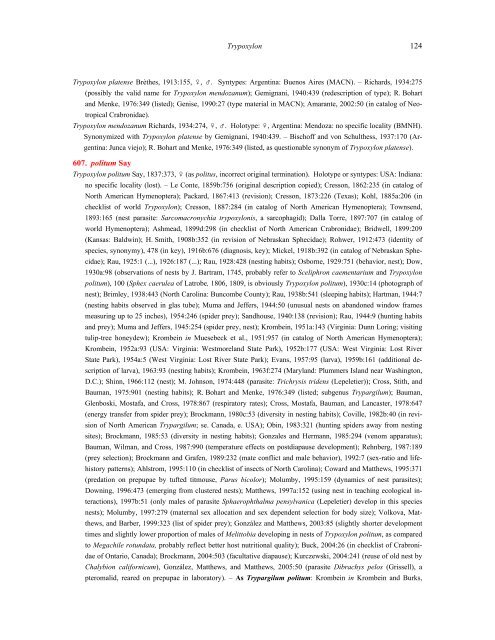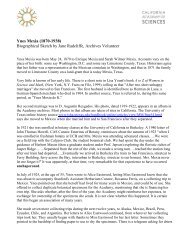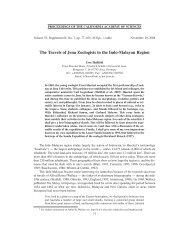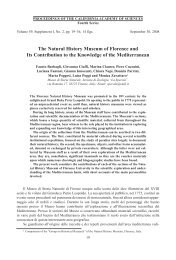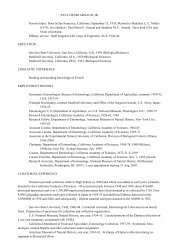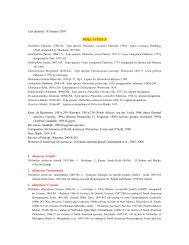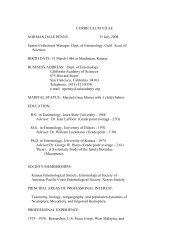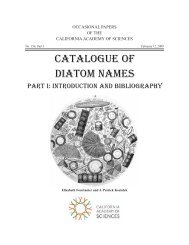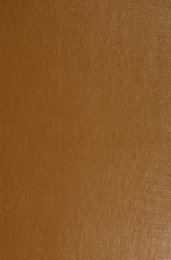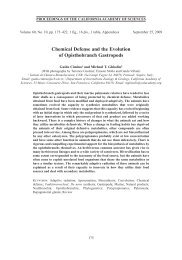TRYPOXYLON - Academy Research
TRYPOXYLON - Academy Research
TRYPOXYLON - Academy Research
You also want an ePaper? Increase the reach of your titles
YUMPU automatically turns print PDFs into web optimized ePapers that Google loves.
Trypoxylon 124<br />
Trypoxylon platense Brèthes, 1913:155, ♀, ♂. Syntypes: Argentina: Buenos Aires (MACN). – Richards, 1934:275<br />
(possibly the valid name for Trypoxylon mendozanum); Gemignani, 1940:439 (redescription of type); R. Bohart<br />
and Menke, 1976:349 (listed); Genise, 1990:27 (type material in MACN); Amarante, 2002:50 (in catalog of Neotropical<br />
Crabronidae).<br />
Trypoxylon mendozanum Richards, 1934:274, ♀, ♂. Holotype: ♀, Argentina: Mendoza: no specific locality (BMNH).<br />
Synonymized with Trypoxylon platense by Gemignani, 1940:439. – Bischoff and von Schulthess, 1937:170 (Argentina:<br />
Junca viejo); R. Bohart and Menke, 1976:349 (listed, as questionable synonym of Trypoxylon platense).<br />
607. politum Say<br />
Trypoxylon politum Say, 1837:373, ♀ (as politus, incorrect original termination). Holotype or syntypes: USA: Indiana:<br />
no specific locality (lost). – Le Conte, 1859b:756 (original description copied); Cresson, 1862:235 (in catalog of<br />
North American Hymenoptera); Packard, 1867:413 (revision); Cresson, 1873:226 (Texas); Kohl, 1885a:206 (in<br />
checklist of world Trypoxylon); Cresson, 1887:284 (in catalog of North American Hymenoptera); Townsend,<br />
1893:165 (nest parasite: Sarcomacronychia trypoxylonis, a sarcophagid); Dalla Torre, 1897:707 (in catalog of<br />
world Hymenoptera); Ashmead, 1899d:298 (in checklist of North American Crabronidae); Bridwell, 1899:209<br />
(Kansas: Baldwin); H. Smith, 1908b:352 (in revision of Nebraskan Sphecidae); Rohwer, 1912:473 (identity of<br />
species, synonymy), 478 (in key), 1916b:676 (diagnosis, key); Mickel, 1918b:392 (in catalog of Nebraskan Sphecidae);<br />
Rau, 1925:1 (...), 1926:187 (...); Rau, 1928:428 (nesting habits); Osborne, 1929:751 (behavior, nest); Dow,<br />
1930a:98 (observations of nests by J. Bartram, 1745, probably refer to Sceliphron caementarium and Trypoxylon<br />
politum), 100 (Sphex caerulea of Latrobe, 1806, 1809, is obviously Trypoxylon politum), 1930c:14 (photograph of<br />
nest); Brimley, 1938:443 (North Carolina: Buncombe County); Rau, 1938b:541 (sleeping habits); Hartman, 1944:7<br />
(nesting habits observed in glas tube); Muma and Jeffers, 1944:50 (unusual nests on abandoned window frames<br />
measuring up to 25 inches), 1954:246 (spider prey); Sandhouse, 1940:138 (revision); Rau, 1944:9 (hunting habits<br />
and prey); Muma and Jeffers, 1945:254 (spider prey, nest); Krombein, 1951a:143 (Virginia: Dunn Loring; visiting<br />
tulip-tree honeydew); Krombein in Muesebeck et al., 1951:957 (in catalog of North American Hymenoptera);<br />
Krombein, 1952a:93 (USA: Virginia: Westmoreland State Park), 1952b:177 (USA: West Virginia: Lost River<br />
State Park), 1954a:5 (West Virginia: Lost River State Park); Evans, 1957:95 (larva), 1959b:161 (additional description<br />
of larva), 1963:93 (nesting habits); Krombein, 1963f:274 (Maryland: Plummers Island near Washington,<br />
D.C.); Shinn, 1966:112 (nest); M. Johnson, 1974:448 (parasite: Trichrysis tridens (Lepeletier)); Cross, Stith, and<br />
Bauman, 1975:901 (nesting habits); R. Bohart and Menke, 1976:349 (listed; subgenus Trypargilum); Bauman,<br />
Glenboski, Mostafa, and Cross, 1978:867 (respiratory rates); Cross, Mostafa, Bauman, and Lancaster, 1978:647<br />
(energy transfer from spider prey); Brockmann, 1980c:53 (diversity in nesting habits); Coville, 1982b:40 (in revision<br />
of North American Trypargilum; se. Canada, e. USA); Obin, 1983:321 (hunting spiders away from nesting<br />
sites); Brockmann, 1985:53 (diversity in nesting habits); Gonzales and Hermann, 1985:294 (venom apparatus);<br />
Bauman, Wilman, and Cross, 1987:990 (temperature effects on postdiapause development); Rehnberg, 1987:189<br />
(prey selection); Brockmann and Grafen, 1989:232 (mate conflict and male behavior), 1992:7 (sex-ratio and lifehistory<br />
patterns); Ahlstrom, 1995:110 (in checklist of insects of North Carolina); Coward and Matthews, 1995:371<br />
(predation on prepupae by tufted titmouse, Parus bicolor); Molumby, 1995:159 (dynamics of nest parasites);<br />
Downing, 1996:473 (emerging from clustered nests); Matthews, 1997a:152 (using nest in teaching ecological interactions),<br />
1997b:51 (only males of parasite Sphaerophthalma pensylvanica (Lepeletier) develop in this species<br />
nests); Molumby, 1997:279 (maternal sex allocation and sex dependent selection for body size); Volkova, Matthews,<br />
and Barber, 1999:323 (list of spider prey); González and Matthews, 2003:85 (slightly shorter development<br />
times and slightly lower proportion of males of Melittobia developing in nests of Trypoxylon politum, as compared<br />
to Megachile rotundata, probably reflect better host nutritional quality); Buck, 2004:26 (in checklist of Crabronidae<br />
of Ontario, Canada); Brockmann, 2004:503 (facultative diapause); Kurczewski, 2004:241 (reuse of old nest by<br />
Chalybion californicum), González, Matthews, and Matthews, 2005:50 (parasite Dibrachys pelos (Grissell), a<br />
pteromalid, reared on prepupae in laboratory). – As Trypargilum politum: Krombein in Krombein and Burks,


